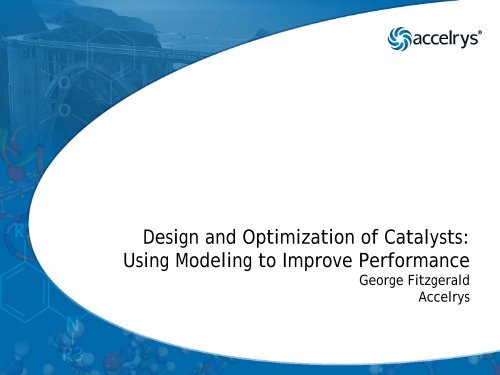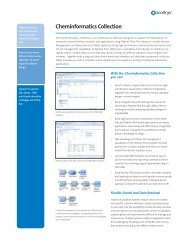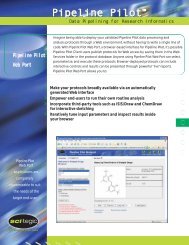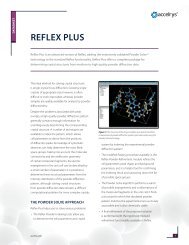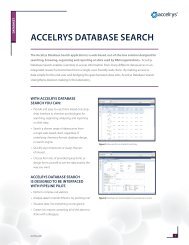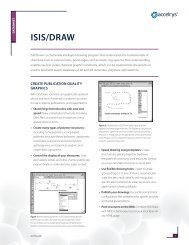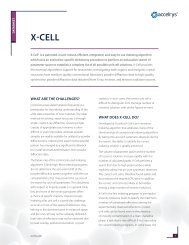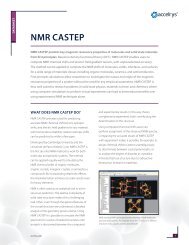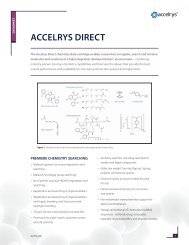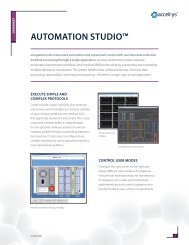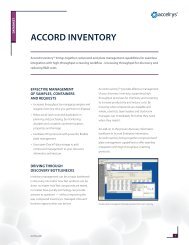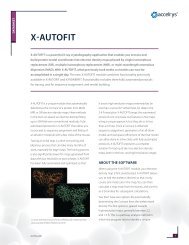Design and Optimization of Catalysts: Using Modeling to ... - Accelrys
Design and Optimization of Catalysts: Using Modeling to ... - Accelrys
Design and Optimization of Catalysts: Using Modeling to ... - Accelrys
Create successful ePaper yourself
Turn your PDF publications into a flip-book with our unique Google optimized e-Paper software.
<strong>Design</strong> <strong>and</strong> <strong>Optimization</strong> <strong>of</strong> <strong>Catalysts</strong>:<br />
<strong>Using</strong> <strong>Modeling</strong> <strong>to</strong> Improve Performance<br />
George Fitzgerald<br />
<strong>Accelrys</strong>
Introduction<br />
• Catalysis is critical <strong>to</strong> modern chemical industry<br />
– 60% <strong>of</strong> chemical products<br />
– 90% <strong>of</strong> chemical processes<br />
– Responsible for $2 billion/year in product sales<br />
• Drivers for improvement<br />
– Rising cost <strong>of</strong> energy<br />
– Rising cost <strong>of</strong> feeds<strong>to</strong>ck<br />
– Environmental regulation<br />
• The role <strong>of</strong> modeling<br />
– Obtain results faster <strong>and</strong> cheaper<br />
– Explore broader range <strong>of</strong> material<br />
– Gain insight at the a<strong>to</strong>mic level
Catalysis from a QM Point <strong>of</strong> View<br />
• Catalyst lowers the reaction energy<br />
barrier, increases rate<br />
• Thermodynamics unchanged<br />
• <strong>Modeling</strong> can provide<br />
– Reaction energies ΔHR – Energy barriers Ea – Location <strong>of</strong> intermediates<br />
• <strong>Modeling</strong> allows you <strong>to</strong> explore in silico<br />
– Effect <strong>of</strong> catalyst composition<br />
– Effect <strong>of</strong> poisons or promoters<br />
– Efficiency <strong>of</strong> catalyst for alternative R<br />
Energy<br />
R<br />
E a,0<br />
With<br />
Catalyst<br />
E a,1<br />
A*<br />
Z 1<br />
Z 2<br />
E a,2<br />
P*<br />
Without<br />
Catalyst<br />
Reaction Coordinate<br />
ΔH R<br />
P
Areas <strong>of</strong> Catalysis <strong>Modeling</strong><br />
Homogeneous Heterogeneous: Heterogeneous:<br />
Zeolites<br />
Surfaces<br />
Roles <strong>of</strong> modeling:<br />
• Identify catalysts<br />
– Catalytic material<br />
– Mechanism<br />
– Active sites<br />
• Optimize catalyst<br />
– Increase yield <strong>and</strong>/or specificity<br />
• Optimize processes<br />
– Diffusion<br />
– Deactivation
Homogeneous Catalysis<br />
• <strong>Design</strong> <strong>and</strong> optimization <strong>of</strong> homogeneous catalysts such as<br />
metallocenes<br />
• Typically designing lig<strong>and</strong>s for<br />
– Control <strong>of</strong> activity<br />
– Control <strong>of</strong> molecular weight<br />
– Control <strong>of</strong> tacticity<br />
• <strong>Modeling</strong> has played a significant role in improving processes,<br />
generation <strong>of</strong> patents, gaining underst<strong>and</strong>ing<br />
R 1<br />
Z<br />
N<br />
R 4<br />
MX 2<br />
R 2<br />
R 3<br />
M= metal, such as transition metal<br />
Z= bridging group such as SiR 2, C 2H 4<br />
X = halide, CH 3
Olefin Polymerization via Metallocene Catalysis<br />
Problem:<br />
• Catalytic efficiency <strong>of</strong> metallocenes depends<br />
upon choice <strong>of</strong> metal, lig<strong>and</strong>, concentration<br />
<strong>of</strong> co-catalyst<br />
• 2 forms <strong>of</strong> catalyst exist: cationic &<br />
bimetallic<br />
• Reaction mechanism is poorly unders<strong>to</strong>od<br />
• How <strong>to</strong> produce optimal catalyst?<br />
Solution:<br />
• Study both cationic vs. bimetallic forms with<br />
theory <strong>and</strong> experiment<br />
Fusco, R. & Longo, L, Macromol. Theory Simul., 3, 895 (1994)<br />
“The multidisciplinary effort<br />
discussed here allowed our<br />
molecular modeling group … <strong>to</strong><br />
contribute substantially <strong>to</strong> the<br />
deposit <strong>of</strong> patents…”<br />
Drs. Longo, Fusco, & Accomazzi,<br />
EniChem
Polymerization Model<br />
• Experiment<br />
– 1 H <strong>and</strong> 13 C NMR <strong>to</strong> identify species<br />
– Mass spec <strong>to</strong> study interaction <strong>of</strong> ionic<br />
catalyst + ethylene<br />
– EPR <strong>to</strong> identify deactivation mechanism<br />
• Computation<br />
– Binding energies<br />
– Activation barriers<br />
– Comparison <strong>of</strong> reaction pathways for<br />
multiple metals, co-catalysts<br />
• Underst<strong>and</strong>ing <strong>of</strong> mechanisms, working<br />
in conjunction with experiment led <strong>to</strong><br />
– Underst<strong>and</strong>ing <strong>of</strong> mechanism<br />
– Several patents<br />
– Improved catalysts<br />
R. Fusco <strong>and</strong> L. Longo, Macromol. Theory Simul., 3, 895 (1994)
EHPP<br />
• Elas<strong>to</strong>meric homopolypropylene<br />
– A rubbery form <strong>of</strong> polypropylene<br />
– Composed <strong>of</strong> alternating blocks <strong>of</strong> isotactic (hard) <strong>and</strong> atactic (s<strong>of</strong>t) PP in the same polymer chain<br />
• Applications in<br />
– Nonwovens for Diapers<br />
– Films for Diaper Components<br />
– Medical Tubing (PVC replacement)<br />
– Medical Film <strong>and</strong> Food Packaging
Stereoblock Polypropylene<br />
A<br />
B<br />
C<br />
D<br />
R1<br />
Zr<br />
R1<br />
Zr<br />
R1<br />
R1<br />
R1<br />
Zr<br />
R1<br />
Zr<br />
R1<br />
R1<br />
isotactic block<br />
atactic block<br />
•Substituent orientation<br />
leads <strong>to</strong> high isotactic vs.<br />
syndiotactic<br />
•Unique opportunity for<br />
control: different polymers<br />
can be made by controlling<br />
side groups<br />
•Isotacticity (% mmmm) very<br />
sensitive <strong>to</strong> K eq<br />
If we can compute K eq, we<br />
can predict isotacticity
Prediction vs. Experiment: Excellent Correlation<br />
H 3 C<br />
H 3 C<br />
F 3 C<br />
F 3 C<br />
Metallocene Eiso– Eatactic<br />
(kcal/mol)<br />
Predicted<br />
polymer type<br />
Observed<br />
polymer type<br />
Predicted<br />
%mmmm<br />
Observed<br />
%mmmm<br />
-0.92 elas<strong>to</strong>meric elas<strong>to</strong>meric medium 39%<br />
Cl Zr Cl<br />
Cl Zr Cl +1.6 atactic atactic low 12%<br />
Cl<br />
Cl<br />
Zr Cl<br />
Zr Cl<br />
CH 3<br />
CH 3<br />
CF 3<br />
CF 3<br />
-0.29 elas<strong>to</strong>meric elas<strong>to</strong>meric medium 31%<br />
-5.3 isotactic isotactic high 75%
Areas <strong>of</strong> Catalysis <strong>Modeling</strong><br />
Homogeneous Heterogeneous: Heterogeneous:<br />
Zeolites<br />
Surfaces<br />
Roles <strong>of</strong> modeling:<br />
• Identify catalysts<br />
– Catalytic material<br />
– Mechanism<br />
– Active sites<br />
• Optimize catalyst<br />
– Increase yield <strong>and</strong>/or specificity<br />
• Optimize processes<br />
– Diffusion<br />
– Deactivation
Adsorption & Catalysis in Microporous Materials<br />
• Properties <strong>of</strong> zeolites determined by<br />
– Pore size<br />
– Acidity<br />
– Extra framework cation<br />
– Framework composition<br />
• Simulation reveals<br />
– Locations <strong>of</strong> adsorption sites<br />
– Interaction energies<br />
– Diffusivity <strong>of</strong> molecules in the pores<br />
• Simulation provides a way <strong>to</strong> correlate<br />
these microscopic properties with<br />
observed activity<br />
Adsorption <strong>of</strong> an organic molecule in zeolite MFI.<br />
Preferred adsorption sides are colored blue
Shape Selectivity vs. Activity<br />
• Controlling selectivity in hydrocracking in zeolites<br />
(Benazzi, et al., J. Catal.217, 376 (2003))<br />
• Compare cracking vs. isomerization<br />
• Activity increases with acidity, but…<br />
• No correlation with selectivity<br />
• Adsorption energy inversely proportional <strong>to</strong> pore<br />
size<br />
– Small pore, high energy cracking<br />
– Large pore, low energy isomerization<br />
• <strong>Modeling</strong> helps guide you <strong>to</strong> the best material<br />
based on rules, trends, correlations deduced from<br />
results
Areas <strong>of</strong> Catalysis <strong>Modeling</strong><br />
Homogeneous Heterogeneous: Heterogeneous:<br />
Zeolites<br />
Surfaces<br />
Roles <strong>of</strong> modeling:<br />
• Identify catalysts<br />
– Catalytic material<br />
– Mechanism<br />
– Active sites<br />
• Optimize catalyst<br />
– Increase yield <strong>and</strong>/or specificity<br />
• Optimize processes<br />
– Diffusion<br />
– Deactivation
DeSO x Catalyst <strong>Design</strong> using Simulation<br />
• Background<br />
– SO 2 is a major air pollutant arising from sulfur in fuels<br />
– Causes acid rain with negative impact on ecosystem, human health <strong>and</strong> buildings <strong>and</strong><br />
monuments<br />
• Oxides can be used <strong>to</strong> catalyze DeSOx reactions<br />
– Key goal is activation <strong>of</strong> the S-O bond in SO 2<br />
– Simulations <strong>and</strong> experiments have been used <strong>to</strong> underst<strong>and</strong> the chemistry <strong>of</strong> SO 2 on oxide<br />
surfaces<br />
Claus reaction<br />
2H 2S + SO 2 → 2H 2O + 3S solid<br />
Reduction <strong>of</strong> SO 2 by CO<br />
SO 2 + 2CO → 2CO 2 + S solid<br />
J. A. Rodriguez et al. JACS, 122, 12362 (2000).
DeSOx Catalyst <strong>Design</strong><br />
O Mg Cr<br />
SO 2 Conversion (%)<br />
100<br />
80<br />
60<br />
40<br />
20<br />
• Why is Cr 0.06Mg 0.94O so active?<br />
• What metal could be used <strong>to</strong> replace Cr?<br />
– Health hazard, environmental impact, cost<br />
SO 2 + 2CO → 2CO 2 + S solid @ 500 C<br />
0<br />
MgO Cr 2O 3 Cr 0.06Mg 0.94O
Calculation <strong>of</strong> SO 2 Adsorption on Surfaces<br />
η 1 -S<br />
Cr<br />
Cr<br />
η 1 -O<br />
Activation <strong>of</strong> S-O bonds<br />
Cr<br />
Mg<br />
η 2 -O,O
Origins <strong>of</strong> SO 2 Activation<br />
• Cr 0.06Mg 0.94O is a good catalyst for<br />
the reduction <strong>of</strong> SO 2 by CO<br />
because<br />
– Occupied electronic states appear<br />
well above the valence b<strong>and</strong> edge<br />
<strong>of</strong> MgO<br />
– The Cr a<strong>to</strong>ms in Cr0.06Mg0.94O are in<br />
a lower oxidation state than the<br />
a<strong>to</strong>ms in Cr2O3 <strong>Design</strong> rule that can now be applied <strong>to</strong> look<br />
for alternative dopants <strong>to</strong> chromium!<br />
State can<br />
hybridize<br />
with the SO 2<br />
LUMO
How can Cr be replaced?<br />
• C<strong>and</strong>idates <strong>to</strong> replace Cr: Mn, Fe, Co, Ni, Zn & Sn<br />
• INMATEL rank according <strong>to</strong> non-chemical fac<strong>to</strong>rs<br />
Mn < Ni < Co < Sn < Zn < Fe<br />
Worst Best<br />
• Approach: compute electronic structure <strong>and</strong> measure dopant level<br />
position above Valence B<strong>and</strong> (VB) edge<br />
Iron looks like<br />
4.5<br />
4.5<br />
4.0<br />
4.0 best choice!<br />
3.5<br />
3.5<br />
3.0<br />
3.0<br />
2.5<br />
2.5<br />
2.0<br />
2.0<br />
1.5 1.5<br />
1.0 1.0<br />
0.5 0.5<br />
0.0 0.0<br />
MgO MgOZnZnSnSn Ni Ni Co Co Fe Mn Cr<br />
Dopant position above<br />
VB edge in eV
Catalyst Test at INMATEL<br />
100 SO 2 Conversion %<br />
80<br />
60<br />
40<br />
20<br />
0<br />
Cr 0.06Mg 0.94O<br />
SO 2 + 2CO → 2C 2O + S solid at 500 C<br />
Zn 0.05Mg 0.95O<br />
Fe0.06Mg0.94O Fe0.06Mg0.94O + K
Effect <strong>of</strong> Surface P on ODH Over SiO 2<br />
Predicting behavior <strong>of</strong> new materials<br />
• ODH <strong>of</strong>fers low-energy alternative <strong>to</strong> C 2H 4<br />
production<br />
– 2 C 2H 6 + O 2 2C 2H 4 + 2H 2O<br />
• SiO 2 is a model catalyst for ODH<br />
• Insertion or substitution <strong>of</strong> P increases %conversion<br />
• Theory provides<br />
– First principle prediction <strong>of</strong> this<br />
– Complete reaction mechanism<br />
– Underst<strong>and</strong>ing <strong>of</strong> the role <strong>of</strong> penta-valent P<br />
• Once mechanism is established, performing “what<br />
if” tests is easy!<br />
A. Maiti, et al., J. Chem. Phys. 117, 8080 (2002)
Areas <strong>of</strong> Catalysis <strong>Modeling</strong><br />
Homogeneous Heterogeneous: Heterogeneous:<br />
Zeolites<br />
Surfaces<br />
Roles <strong>of</strong> modeling:<br />
• Identify catalysts<br />
– Catalytic material<br />
– Mechanism<br />
– Active sites<br />
• Optimize catalyst<br />
– Increase yield <strong>and</strong>/or specificity<br />
• Optimize processes<br />
– Diffusion<br />
– Deactivation
Learning More from UV-Visible<br />
Spectroscopy & The Role <strong>of</strong> Defects in<br />
Selective Propane Ammoxidation:<br />
<strong>Modeling</strong> Defects in Vanadyl<br />
Pyrophosphate<br />
Gerry Zajac, Innovene USA LLC, Naperville, IL<br />
60563
BP’s Maleic Anhydride Technology<br />
Fluid-Bed - Reac<strong>to</strong>r<br />
Oxidation Section<br />
Steam Export<br />
Butane Maleic<br />
Air<br />
Fluid Bed Reac<strong>to</strong>r<br />
Butane <strong>to</strong> Maleic Anhydride<br />
• Fluid-Bed Catalyst<br />
• Single Phase Material<br />
• No Added Hardening Agent<br />
• 100 % Vanadyl Pyrophosphate (VO)2P2O7<br />
Anhydride
(VO) 2P 2O 7 is key <strong>to</strong> Maleic Anhydride<br />
Manufacture<br />
• Catalyst Activation is well unders<strong>to</strong>od:<br />
2 VOHPO 4 → (VO) 2P 2O 7 + H 2O<br />
• What happens during Catalyst Deactivation?<br />
– Known that Phosphorous is lost<br />
– Analytical measurements show changes in XPS, UV<br />
– But structure <strong>of</strong> deactivated catalyst, deactivation mechanism are not<br />
known<br />
• What is the structure <strong>of</strong> deactivated Vanadyl Pyrophosphate?
UV-VIS Absorption (VO) 2P 2O 7<br />
• Spectrum provides a fingerprint <strong>of</strong> active vs. deactivated catalyst<br />
• Compute spectrum for several hypothetical deactivated structures<br />
• Continue until match between computation & experiment<br />
• Not blind guessing:<br />
– Loss <strong>of</strong> P is know from elemental analysis<br />
– Shift <strong>of</strong> XPS <strong>to</strong> lower energy O 2s energy implies loss <strong>of</strong> PO 2
Vanadyl Pyrophosphate Unit Cells<br />
Vanadyl Pyrophosphate Unit Cell<br />
Vacancy Model - Loss <strong>of</strong> PO 2 +<br />
• Deactivation <strong>of</strong> (VO) 2P 2O 7 corresponds <strong>to</strong> loss <strong>of</strong> PO 2 +<br />
• Experimental evidence <strong>of</strong> these defects by XPS <strong>and</strong> UV-visible<br />
spectroscopy<br />
• Computation can be used <strong>to</strong> verify detailed crystal structure <strong>of</strong><br />
deactivated material<br />
• Future: Can we determine the mechanism <strong>and</strong> how <strong>to</strong> prevent it?
R1<br />
Iterate <strong>and</strong> Try Again<br />
Zr<br />
R1<br />
Select catalyst<br />
material<br />
Guest molecule<br />
docking<br />
Reaction<br />
modeling<br />
• Develop mechanistic underst<strong>and</strong>ing<br />
• Create empirical model, e.g. QSAR<br />
Energy<br />
R G<br />
E a,0<br />
With<br />
catalyst<br />
– Create a function <strong>to</strong> predict properties in terms <strong>of</strong> “descrip<strong>to</strong>rs”, e.g.,<br />
solubility, binding energy, molecular surface area<br />
• Determine values <strong>of</strong> descrip<strong>to</strong>rs that yield optimum behavior, <strong>and</strong> use<br />
corresponding materials<br />
• Refine the model as you test each new material<br />
A*<br />
Z 1<br />
Z 2<br />
E a,1 E a,2<br />
P*<br />
Without<br />
catalyst<br />
Reaction Coordinate<br />
ΔH R<br />
Deactivation Success!
S<strong>of</strong>tware for <strong>Modeling</strong><br />
• Adsorption <strong>and</strong> docking <strong>of</strong> molecules<br />
– Use empirical force fields<br />
– Fast but approximate calculations<br />
– Typically require ≈10 6 conformations<br />
– Programs: Forcite, COMPASS, Sorption<br />
• Reactions, bond breaking<br />
– Require methods that use quantum<br />
mechanics<br />
– Accurate but time-consuming calculations<br />
– Programs: CASTEP, DMol3 • Ease <strong>of</strong> use is essential: Materials Studio<br />
• High-performance hardware is critical
Summary<br />
• <strong>Modeling</strong> can be used <strong>to</strong><br />
– Make prediction about catalyst performance<br />
– Underst<strong>and</strong> reaction mechanisms<br />
– Provide information that lets you design better catalysts<br />
• The examples here used modeling <strong>to</strong><br />
– Model guest molecules in zeolites<br />
– Predict performance <strong>of</strong> a polymerization catalyst<br />
– Improving ODH performance with dopants<br />
– Find alternatives <strong>to</strong> using <strong>to</strong>xic Cr<br />
– Verify the structure <strong>of</strong> deactivated (VO) 2P 2O 7 catalyst


